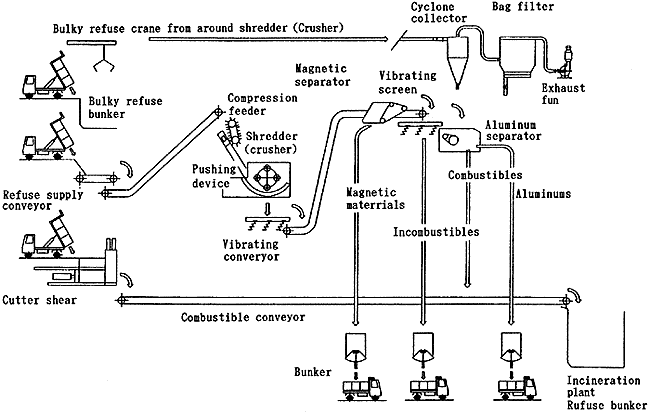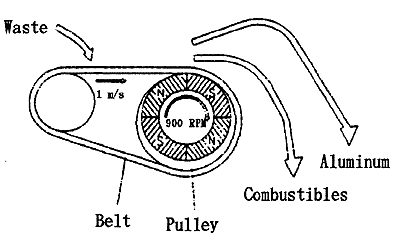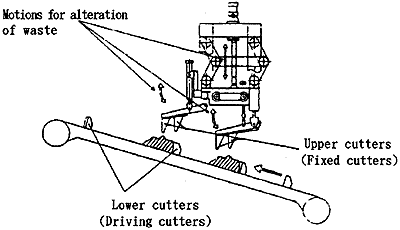Waste Treatment Technology in JAPAN
Crushing, Sorting
Also, the Hand Selection Equipment is required in order to allow recycling and reclamation as resources of empty cans, bottles, cullets, and waste paper.
Fig.1
The Facility can be configured to meet a wide range of demands by effectively combining those equipment that have shown excellent performance characteristics into the individual Equipment. The crusher, the main equipment for the Facility, is manufactured by the Mitsubishi Heavy Industries, Ltd. which provides stable and efficient crushing in combination with a compression feeder. Also, the cutter shear is most helpful for crushing of combustible bulk wastes.
In addition, various equipment into which our unique design ideas have been incorporated are used including the separator, transporting equipment, and storage and delivery equipment.
- Aluminum separator (belt-pulley type)
An array of permanent magnets mounted in a front pulley have their north and south poles alternately arranged. And this magnet array is rotated at a high speed. A sudden change in the magnetic field will produce eddy current in aluminum debris contained in waste being delivered on a belt. So these aluminum debris will be subject to repulsion and only they will be repelled out from the waste and be selected .
The magnet uses a rare earth magnet which provides large repelling force to ensure that small quantities of iron debris present in waste will produce no problem.
- Bag tearing machine
This machine can tear bags without breaking bottles contained in them. This also helps creating a uniform flow of waste, which allows a constant flow of waste discharged to the backflow side.1. Purpose
The BULKY WASTE CRUSHING PLANT is primarily designed to crush bulky and incombustible wastes resulting from home life. The plant provides crushing, selection, volume reduction, and recycling as resources of such domestic wastes so that it reduces the quantities of wastes incinerated, prolongs the life of land fills, and recovers the resources.
2. Capacity
The Facility has the capacity to meet all requirements in planning this type of facility such as the nature of waste, reception method, types of selected wastes, storage and delivery methods as well as throughput as the major requirement. Also, our unique design considerations have been provided for pollution prevention, including design attention to satisfying the standard values for prevention of noise, vibration, air pollution and other environmental pollution.
3. Plant Configuration
The Bulky Waste Crushing Plant mainly consists of the following:
Reception Equipment, Crushing Equipment, Transporting Equipment, Selection Equipment, Storage and Delivery Equipment, Water Supply and Drainage Equipment, Dust Collection Equipment, Electrical Instrumentation Equipment, and Civil and Building facilities.
Fig. 1 shows a diagram of a typical Facility flow.

4. Features
As the whole plant, waste spillage preventing measures, safety measures for improved working environment, and maintenance measures have been introduced into the Facility so that burdensome task for working personnel may be reduced.
The belt-pulley aluminum separator features smaller installation space and higher purity and higher recovery rate than the conventional type.
Fig. 2
Fig. 2 shows a principle diagram of this separator.

If hand selection lines are included for recycling as resources of waste, it is needed to provide a bag tearing operation in between the supply of waste and the delivery to hand selection conveyers. This operation is mechanically performed by means of the bag tearing machine.
Fig. 3
As shown in Fig. 3, waste bags are torn by driving cutters on the apron conveyor and fixed cutters located above the conveyor.
